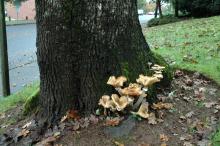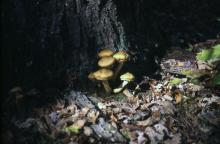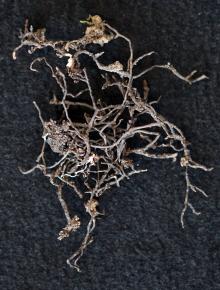See:
Plants Resistant or Susceptible to Armillaria Root Rot
Cause Armillaria mellea is likely the species on various hardwoods and/or fruit trees. The fungus can live many years as a saprophyte in soil, on infected stumps, roots, and other organic matter. It breaks down the lignin and cellulose in plant tissue. Natural oak-root infections will not threaten the native oak's life. A few roots may be infected, but the tree can replace them. This balance can be maintained throughout the tree's lifespan without serious damage unless the balance tips in favor of fungal growth and against root growth. Surface watering in warm months softens the main roots in the crown area and favors the progress of the fungus. This is a soilborne fungus that is capable of attacking many different plant hosts. These fungi are most commonly found in forests and natural areas where they infect a variety of trees and shrubs.
This fungus may form mushrooms at the base of infected trees in fall and winter. Mushrooms are honey-colored or light tan, with a stalk 4 to 6 inches or more in height and a cap 2 to 4 inches across, often dotted with brown scales. Spores are formed along the gills and are wind-blown. Spores are not a significant means of infecting healthy plants but can colonize old stumps and dead trees. The fungus spreads vegetatively, below ground, which leads to the formation of groups of dead and dying plants called "disease centers." The fungus can survive on woody host roots long after the host dies. Its vegetative fungal tissue (mycelium) decomposes root wood for nutrients as it grows. When infected plants are removed, infected roots that remain below ground serve as a source of inoculum for new plants placed in the same location.
Symptoms The first visible disease symptom is a decline and dieback in which leaves turn yellow, wilt, and die. At ground level and just below, white felt-like masses of fungus grow on the plant crown between the bark and the wood. Scattered through the soil are black shoestring-like strands called rhizomorphs. Rhizomorphs may look like roots on the outside but have an entirely different structure when cut open in cross-section.
Cultural control
- For oak and many shade trees, removing soil in a 3-ft radius of the crown and the main trunk root area to minimize conditions that favor the fungus.
- Water deeply when watering is needed. Avoid watering lawns under trees or any surface watering that might wet the crown and trunk root area.
- Trees that are vigorous, as a result of favorable climate and sound cultural practices usually are more tolerant.
- If removing infected trees, remove as much of the root system as possible and replant with resistant species such as Madrone or mulberry (see the table "Plants Resistant or Susceptible to Armillaria Root Rot," in Section 3).
Reference Shaw, C.G. and Kile, G.A. 1991. Armillaria Root Disease. USDA Forest Service Agriculture Handbook No. 691.




